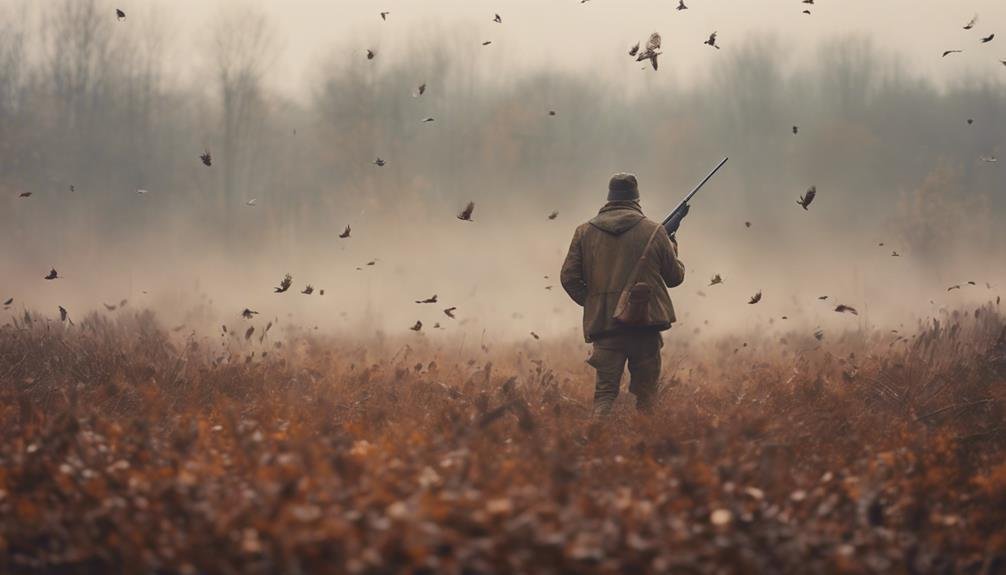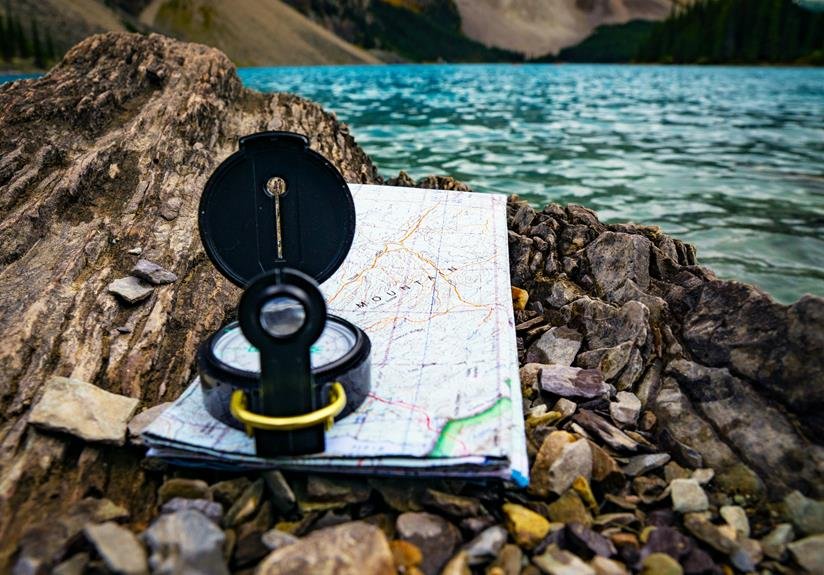You're consistently coming up empty-handed in the field, and it's not because of bad luck – it's because of fatal flaws in your technique that are costing you birds. Your shooting stance is off, causing you to miss easy shots. You're not mastering gun mounting, which is throwing off your aim. And when it comes to tracking, you're focusing on where the bird is, not where it's headed. By addressing these flaws and adapting to changing hunting conditions, you can turn your season around. Take a closer look at your techniques and strategies – you might be surprised at what you've been overlooking.
Key Takeaways
- Pinpoint and correct flaws in shooting technique, such as improper stance, to improve accuracy and reduce missed shots.
- Master bird tracking and shot analytics to identify and correct high shots and other errors.
- Focus on the bird's trajectory, anticipating where it will be, rather than where it is, to improve leading and accuracy.
- Practice smooth, fluid motion, avoiding jerky movements, and maintain a consistent gun fit to ensure accurate shots.
- Adapt to changing hunting conditions, such as shifting pheasant habitats, to increase chances of a successful hunt.
Correcting Shooting Stances
When you're preparing to take aim at a pheasant, the first thing to check is your stance, as even slight misalignments can throw off your entire shot. You want to maintain proper posture, with your weight evenly distributed between both feet and your body balanced evenly. Footwork fundamentals are vital – point your front foot in the direction the bird is heading, not where it was. This allows you to move with the bird, not stuck in one spot. By doing so, you'll be able to move smoothly and control your gun more effectively. Remember, a slight misstep in your stance can lead to a missed shot, so take the time to get it right.
Mastering Gun Mounting Techniques
By mastering the art of mounting your shotgun, you'll be able to align your body, gun, and target seamlessly, resulting in a smooth, accurate shot. A proper gun fit is essential, as it affects your ability to mount the gun comfortably and consistently. To develop muscle memory, practice mounting your shotgun regularly, focusing on a smooth, fluid motion. Avoid jerky movements, which can throw off your aim.
| Mounting Technique | Benefits | Common Mistakes |
|---|---|---|
| Point front foot in direction of bird | Improves balance and control | Pointing foot in wrong direction |
| Bring barrel into line of vision | Aligns eye with barrel and target | Dropping head onto stock too soon |
| Marry cheek to stock | Ensures consistent gun fit and control, leading to precise shots | Failing to develop muscle memory
Overcoming High Shots
To break the curse of high shots, you need to pinpoint the flaws in your shooting technique, as even slight miscalculations can send your pellets soaring over the pheasant's head. One common issue is failing to track the bird correctly, leading to poor shot analytics. You must focus on the bird's trajectory, anticipating where it'll be, not where it is. This requires a smooth, fluid motion, keeping your gun below the bird for a clear view. Avoid focusing on the bead or sight; instead, keep your eyes on the target. By mastering bird tracking and shot analytics, you'll reduce high shots and start hitting your mark consistently. Remember, it's not just about pulling the trigger – it's about understanding the dynamics of the hunt.
Effective Bird Leading Strategies
Mastering the art of leading birds is essential for pheasant hunters, as it's the difference between bringing home the bacon and going home empty-handed. Leading a bird requires anticipating its flight pattern and speed. You need to stay focused on the bird's trajectory, not just its current position. Here's a helpful guide to keep in mind:
| Bird Speed | Lead Time |
|---|---|
| 20-30 mph | 2-3 ft |
| 30-40 mph | 4-5 ft |
| 40-50 mph | 6-7 ft |
| 50+ mph | 8-10 ft |
| Unpredictable | Adjust accordingly |
Late-Season Hunting Advantage
As you've honed your leading skills, now it's time to capitalize on the late-season hunting advantage, when pheasants are more concentrated and fewer hunters are afield, making it an ideal time to bag your limit. This is when pheasants become more predictable in their behavior, following established patterns and habits.
Here are three key advantages of late-season hunting:
- Concentrated birds: Pheasants are more bunched up, making it easier to find and flush them.
- Fewer hunters: You'll face less competition, allowing you to focus on your hunting tactics without distractions.
- Established patterns: Pheasants follow established patterns, making it easier to anticipate and prepare for their movements.
Flushing Birds From Thick Cover
With thick cover providing the perfect hiding spot, you'll often find yourself pushing through dense vegetation to flush out a rooster, requiring a combination of strategy and instinct to successfully put birds in the air. When analyzing cover, look for areas with dense, tangled vegetation, as these are likely to harbor birds. Consider the bird's behavior, too – roosters tend to congregate in areas with abundant food and shelter. As you push through the cover, move slowly and deliberately, using your senses to detect subtle signs of bird activity. Keep your wits about you, staying alert for the sudden burst of feathers and wings that signals a flushed bird. By combining cover analysis with an understanding of bird behavior, you'll increase your chances of successfully flushing birds from thick cover.
Developing Essential Hunting Skills
You'll need to hone a range of skills, from shooting techniques to hunting strategies, to become a proficient pheasant hunter. Developing essential hunting skills requires attention to detail and practice. Here are three key areas to focus on:
- Shooting Techniques: Master proper gun mounting, weight distribution, and barrel control to improve your accuracy.
- Hunting Strategies: Learn to read bird behavior, adapt to changing conditions, and employ effective hunting etiquette.
- Safety Protocols: Always prioritize safety, following protocols for gun handling, wearing proper gear, and respecting fellow hunters' space.
Improving Duck Calling Techniques
Mastering the art of duck calling requires dedication and consistent practice, much like honing your shooting skills or developing an effective hunting strategy. You need to understand duck behavior and socialization patterns to effectively mimic their sounds. Start by learning the basics of quacks, feeder calls, and whistle sounds. Practice regularly to develop muscle memory and improve your tone, pitch, and rhythm. Don't neglect call maintenance – clean and lubricate your call regularly to guarantee top-notch performance. Remember, a good duck call is only as good as the hunter using it. With patience and persistence, you'll be calling in ducks like a pro in no time.
Essential Gear for Hunting Success
Having the right gear can make all the difference between a successful hunt and a disappointing one, so it's essential you invest in essential items that'll help you bag that elusive rooster or limit of ducks.
Must-haves for a successful hunt:
- Reliable Shotgun: Invest in a shotgun that's dependable, durable, and suitable for the type of hunting you'll be doing.
- Well-Maintained Gear: Regular gear maintenance is key to confirming your equipment is in top condition. Clean and lubricate your shotgun, and check your blind essentials regularly to prevent malfunctions.
- Blind Essentials: A well-equipped blind is fundamental for success. Make sure you have all the necessary blind essentials, such as comfortable seating, camouflage, and adequate storage.
Common Mistakes in Shotgun Mounting
As you prepare to take aim, a faulty shotgun mount can throw off your entire shot, making it imperative to identify and correct common mistakes in your mounting technique. A poor gun fit can lead to mounting issues, affecting your shooting form and barrel alignment. Verify a proper stock adjustment, allowing you to maintain a consistent cheek pressure. Avoid dropping your head onto the stock after the butt is in place, as this can cause high shots and inaccuracy. Instead, bring the barrel into line of vision while marrying your cheek to the stock, keeping your head moving forward with the gun. By correcting these common mistakes, you'll improve your shooting form and increase your chances of hitting your target.
Enhancing Hunting Strategies
You can substantially improve your pheasant hunting success by adapting your strategies to the changing behaviors and habitats of your quarry throughout the season. As the season progresses, pheasants adjust to hunting pressure, altering their habits and habitats. To stay effective, you must adjust your tactics accordingly. Here are three key strategies to enhance your hunting success:
- Adapt to changing habitats: As crops are harvested, pheasants shift to alternative habitats, such as CRP fields or wetlands. Be prepared to adapt your hunting grounds to match their new habitats.
- Respect Hunting Ethics: Always prioritize fair chase and respect for the land and its owners. This maintains a positive experience for all involved and preserves access to quality hunting grounds.
- Practice Land Management: Implement conservation practices, such as habitat restoration and wildlife-friendly farming, to create a thriving environment for pheasants and other wildlife.
Frequently Asked Questions
How Do I Maintain Focus While Tracking a Fast-Moving Pheasant?
When tracking a fast-moving pheasant, you'll maintain focus by practicing eye discipline, keeping your gaze soft and focused on the bird, and using mental tricks like visualization to stay locked in and avoid distractions.
Can I Use the Same Shotgun for Both Pheasant and Waterfowl Hunting?
You're probably aware that 70% of hunters own just one shotgun, making versatility a must. For pheasant and waterfowl hunting, use a 12-gauge shotgun with versatile calibers like 2 3/4" or 3" shells, and select ammo suitable for each game bird's size and range.
Are There Specific Clothing and Gear Recommendations for Late-Season Hunting?
"When late-season hunting, you'll want to prioritize warmth and dryness. Wear insulating layers, waterproof boots, and camo patterns that blend with the snowy landscape. Don't forget hand warmers to keep your fingers toasty and nimble."
How Often Should I Practice My Duck Calling Skills to See Improvement?
As you "whistle in the dark," practicing duck calling skills daily, even just 10-minute morning drills, will refine your technique, much like a musician's daily scales, to lure in those ducks with confidence.
What Is the Ideal Distance for Flushing Pheasants in Thick Cover?
When flushing pheasants in thick cover, you'll want to position yourself 15-20 yards from the bird, allowing for a clear shot while considering cover analysis and bird behavior, ensuring a successful hunt.
Conclusion
As you slip back into the field, the rustling of leaves underfoot echoes the rustling of doubts in your mind. But this time, it's different. You've confronted your fatal flaws, faced your weaknesses, and fine-tuned your skills. The next rooster you flush won't escape; it'll fall at your feet. Coincidence has it that the birds are waiting, and so is your triumph. Now, shoulder your shotgun, take a deep breath, and let the hunt begin.









